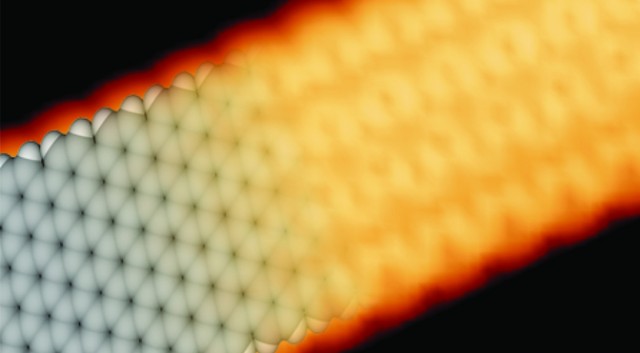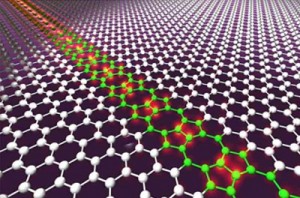It looks like you're using an Ad Blocker.
Please white-list or disable AboveTopSecret.com in your ad-blocking tool.
Thank you.
Some features of ATS will be disabled while you continue to use an ad-blocker.
5
share:
With each new generation of microchips, transistors are being placed closer and closer together. This can only go on so long before there’s no more room to improve, or something revolutionary has to come along to change everything. One of the materials that might be the basis of that revolution is none other than graphene. Researchers at the University of California at Berkeley are hot on the trail of a form of so-called nanoribbon graphene that could increase the density of transistors on a computer chip by as much as 10,000 times.
Graphene nanoribbons could be the savior of Moore’s Law


Seem to be rather a few emerging technologies doing the rounds these days that challenge Moore's law to some degree or another. Most of them seem to be employ the use of Graphene and Nanotechnology over our standard Silicon production techniques.
What are your thoughts fellow ATS members regarding these emerging technologies and the future of integrated circuits as we know them?
edit on 24-2-2014 by andy06shake because: (no reason given)
reply to post by andy06shake
How did we not discover graphene earlier? It's a single atom compound!!
I'm looking forward to what they can achieve with this.
How did we not discover graphene earlier? It's a single atom compound!!
I'm looking forward to what they can achieve with this.
reply to post by iRoyalty
I think silicon was a lot easier to work with and engineer back then than Graphene hence its use. Also the electrical properties of Graphene regarding electronic and electrical engineering were not discovered until 1985 when Klaus von Klitzing received the Nobel prize for his discovery.
en.wikipedia.org...
I think silicon was a lot easier to work with and engineer back then than Graphene hence its use. Also the electrical properties of Graphene regarding electronic and electrical engineering were not discovered until 1985 when Klaus von Klitzing received the Nobel prize for his discovery.
en.wikipedia.org...
edit on 24-2-2014 by andy06shake because: (no reason given)
Actually, even if that concept could be put into manufacturing soon enough (which is unlikely), it would only delay the inevitable a generation or
two. I'd expect a need for cell redundancy to correct for other serious issues which seem likely.
Having only a couple of charges (or just one!) in a channel will be accompanied by a huge increase in signal uncertainty when there is an increase or decrease of a single electron or hole. That delta of 1 charge is a 33% to 50% change. With 5 or more charges in a channel, it's a lot different.
With smaller cells, and fewer than 5 charges in a channel, we can use redundancy in parallel small cells to "vote" for whether a 1 or 0 is believed to exist. It would be wise to use an odd number of parallel cells or there would be a question of what to do with ties.....
IMO Moore's law is already dead for CMOS.
Having only a couple of charges (or just one!) in a channel will be accompanied by a huge increase in signal uncertainty when there is an increase or decrease of a single electron or hole. That delta of 1 charge is a 33% to 50% change. With 5 or more charges in a channel, it's a lot different.
With smaller cells, and fewer than 5 charges in a channel, we can use redundancy in parallel small cells to "vote" for whether a 1 or 0 is believed to exist. It would be wise to use an odd number of parallel cells or there would be a question of what to do with ties.....
IMO Moore's law is already dead for CMOS.
edit on 24-2-2014 by BayesLike because: (no reason given)
Perhaps they shouldn't have taken it so literally and instead called it "Moore's Rule of Thumb, give or take" ?
Because obviously all it takes is a few nukes or a Carrington class Solar Storm to set us back significantly.
Or people could grow lazy, unproductive, and lose their motivation to innovate. Etc.
All sorts of reasons why it's not an actual "Law" but rather more of like a "Suggested Guideline for inference and projection purposes".
Besides, the wiki on it says :
"Approximately" ?
So it's like in religion, when you take a suggestion to an extreme it becomes unrealistic.
Well this particular "Law" isn't realistic in a completely literal understanding.
It's "Approximated" with "Reality". You can create "Simulations" with it.
BTW- Thanks for the thread OP, it's always good to discuss these new emerging technologies and their potentials.
Because obviously all it takes is a few nukes or a Carrington class Solar Storm to set us back significantly.
Or people could grow lazy, unproductive, and lose their motivation to innovate. Etc.
All sorts of reasons why it's not an actual "Law" but rather more of like a "Suggested Guideline for inference and projection purposes".
Besides, the wiki on it says :
Moore's law is the observation that, over the history of computing hardware, the number of transistors on integrated circuits doubles approximately every two years
"Approximately" ?
Very similar; closely resembling:
So it's like in religion, when you take a suggestion to an extreme it becomes unrealistic.
Well this particular "Law" isn't realistic in a completely literal understanding.
It's "Approximated" with "Reality". You can create "Simulations" with it.
BTW- Thanks for the thread OP, it's always good to discuss these new emerging technologies and their potentials.
For some why reason I thought grapheme could be used in nuclear cleanup......what ever happened to that prediction?
Id say we are badly in need of something like that.......
More transistors on a chip doesn't cut it, but it will be interesting in the future.....
This stuff sounds like a wonder drug for technology....
Id say we are badly in need of something like that.......
More transistors on a chip doesn't cut it, but it will be interesting in the future.....
This stuff sounds like a wonder drug for technology....
reply to post by stirling
I think NASA toyed with the idea of using a graphene based radiation shield on one of there future Mars missions and you are correct it also has the ability to quickly remove radioactive material from contaminated water, apparently something to do with the graphene oxide’s large surface area. The properties of this substance are indeed varied and rather interesting to say the least but trust me more transistors on a chip as you put it will only lead to even more remarkable breakthroughs in the fields of physics, mathematics and computing.
I think NASA toyed with the idea of using a graphene based radiation shield on one of there future Mars missions and you are correct it also has the ability to quickly remove radioactive material from contaminated water, apparently something to do with the graphene oxide’s large surface area. The properties of this substance are indeed varied and rather interesting to say the least but trust me more transistors on a chip as you put it will only lead to even more remarkable breakthroughs in the fields of physics, mathematics and computing.
edit on 24-2-2014 by andy06shake because:
(no reason given)
reply to post by BayesLike
Quantum effects were bound to put limits on transistor density sooner or later so even if this worked, it's only delaying the inevitable.
reply to post by muzzleflash
I agree use of the word "law" probably wasn't the best choice, maybe "Moore's correlation" would be more appropriate. It's not really a law, because we already know enough quantum mechanics to be pretty sure that transistor density increases can't continue without limit.
Quantum effects were bound to put limits on transistor density sooner or later so even if this worked, it's only delaying the inevitable.
reply to post by muzzleflash
I agree use of the word "law" probably wasn't the best choice, maybe "Moore's correlation" would be more appropriate. It's not really a law, because we already know enough quantum mechanics to be pretty sure that transistor density increases can't continue without limit.
Shrink the batteries and shrinkable display first, then we can talk about making it smaller.
No use having 1 atom transistor with batteries/display size the size of your palm, still didnt get smaller.
No use having 1 atom transistor with batteries/display size the size of your palm, still didnt get smaller.
reply to post by NullVoid
I imagine that's where "Heads Up Displays" like Google glass will make there mark as to the batteries size and life cycle, those technologies are also maturing, becoming more efficient and compact.
However there is more of a market for the applications of this technology than the mobile device industry's.
Personally i like my displays big!
I imagine that's where "Heads Up Displays" like Google glass will make there mark as to the batteries size and life cycle, those technologies are also maturing, becoming more efficient and compact.
However there is more of a market for the applications of this technology than the mobile device industry's.
Personally i like my displays big!
edit on 25-2-2014 by andy06shake because: (no reason given)
new topics
-
OK this is sad but very strange stuff
Paranormal Studies: 5 hours ago -
Islam And A Book Of Lies
Religion, Faith, And Theology: 6 hours ago -
Sorry to disappoint you but...
US Political Madness: 8 hours ago
top topics
-
Sorry to disappoint you but...
US Political Madness: 8 hours ago, 13 flags -
Watch as a 12 million years old Crab Emerges from a Rock
Ancient & Lost Civilizations: 13 hours ago, 10 flags -
OK this is sad but very strange stuff
Paranormal Studies: 5 hours ago, 6 flags -
Islam And A Book Of Lies
Religion, Faith, And Theology: 6 hours ago, 5 flags
active topics
-
Joe Biden gives the USA's Highest Civilian Honor Award to Hillary Clinton and George Soros.
US Political Madness • 48 • : Flyingclaydisk -
ILLUMINATION: Dimensions / Degrees – Da Vincis Last Supper And The Philosophers Stone
Secret Societies • 6 • : Compendium -
Sorry to disappoint you but...
US Political Madness • 15 • : Flyingclaydisk -
Meta Llama local AI system is scary good
Science & Technology • 39 • : Arbitrageur -
Musk calls on King Charles III to dissolve Parliament over Oldham sex grooming gangs
Mainstream News • 180 • : Freeborn -
Islam And A Book Of Lies
Religion, Faith, And Theology • 3 • : nugget1 -
Outgoing Lame Duck BIDEN Officials and Democrats Voice Their Regrets.
2024 Elections • 30 • : WeMustCare -
Tesla Cybertruck Explodes in Front of Trump Hotel in Las Vegas
Mainstream News • 229 • : Daughter2v2 -
What Is 'Quad Demic'? Mask Mandate Returns In These US States
Diseases and Pandemics • 39 • : AdultMaleHumanUK -
OK this is sad but very strange stuff
Paranormal Studies • 2 • : Ravenwatcher
5
